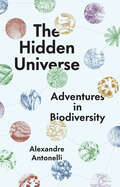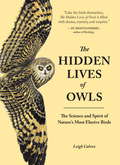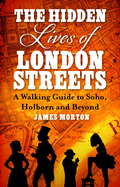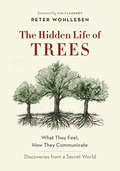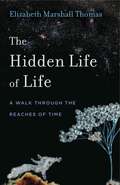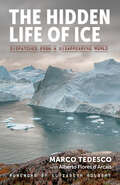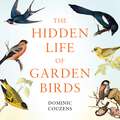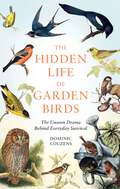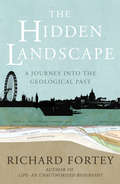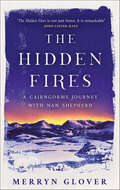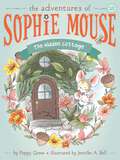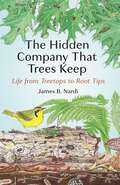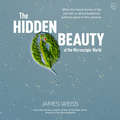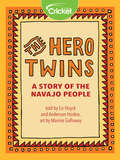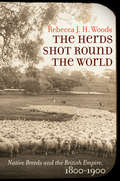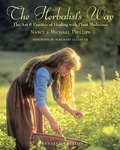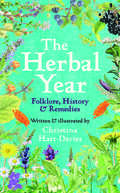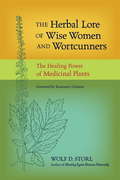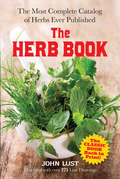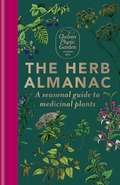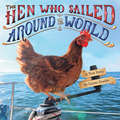- Table View
- List View
The Hidden Universe: Adventures in Biodiversity
by Alexandre AntonelliAn unforgettable exploration of the natural world and the concept of biodiversity—what it is, why it matters, and how we as individuals can work to preserve it. We are now living in an environmental emergency. As climate change, habitat loss, and other threats have placed almost one-fifth of all species on Earth at risk of extinction in the coming decades, a deeper understanding of biodiversity has never been more important. Biodiversity encompasses the rich variety of all life on Earth—the building blocks of life that provide invaluable sources of food, medicine, clothing, building materials, and more. Marking the arrival of a bold new voice in popular science, The Hidden Universe shows readers what’s at stake in the fight to protect and restore biodiversity, but also what can and should be done now to protect our planet and ourselves for the future. As director of science at one of the world’s largest research organizations in plant and fungal sciences, Brazilian-born scientist Alexandre Antonelli is ideally suited to reveal the wonders of biodiversity at a genetic, species, and ecosystem level—what biodiversity is, how it works, and why it is the most important tool in our battle against climate change. Antonelli offers recommendations for large-scale political changes, as well as smaller, practical steps that readers can implement in their own lives and homes. With Antonelli as our guide, The Hidden Universe helps us imagine a future where biodiversity is not just preserved but cherished.
The Hidden Universe: Adventures in Biodiversity
by Alexandre AntonelliAn unforgettable exploration of the natural world and the concept of biodiversity—what it is, why it matters, and how we as individuals can work to preserve it. We are now living in an environmental emergency. As climate change, habitat loss, and other threats have placed almost one-fifth of all species on Earth at risk of extinction in the coming decades, a deeper understanding of biodiversity has never been more important. Biodiversity encompasses the rich variety of all life on Earth—the building blocks of life that provide invaluable sources of food, medicine, clothing, building materials, and more. Marking the arrival of a bold new voice in popular science, The Hidden Universe shows readers what’s at stake in the fight to protect and restore biodiversity, but also what can and should be done now to protect our planet and ourselves for the future. As director of science at one of the world’s largest research organizations in plant and fungal sciences, Brazilian-born scientist Alexandre Antonelli is ideally suited to reveal the wonders of biodiversity at a genetic, species, and ecosystem level—what biodiversity is, how it works, and why it is the most important tool in our battle against climate change. Antonelli offers recommendations for large-scale political changes, as well as smaller, practical steps that readers can implement in their own lives and homes. With Antonelli as our guide, The Hidden Universe helps us imagine a future where biodiversity is not just preserved but cherished.
The Hidden Lives of Owls: The Science and Spirit of Nature's Most Elusive Birds
by Leigh CalvezA naturalist probes the forest, mainly at night, to comprehend the secret lives of owls in this book that will appeal to readers of Crow Planet and H is for Hawk. Join Leigh Calvez on adventures into the world of owls: owl-watching, avian science, and the deep forest--often in the dead of night. These birds are a bit mysterious, and that's part of what makes them so fascinating. Calvez makes the science entertaining and accessible while exploring the questions about the human-animal connection, owl obsession, habitat, owl calls, social behavior, and mythology.From the Trade Paperback edition.
The Hidden Lives of London Streets: A Walking Guide to Soho, Holborn and Beyond
by James MortonLondon's streets have always worn a variety of influences, reflecting the diverse crowds who live and work on them. Take a walk down any number of historic streets and an abundance of tales exist in the bricks and mortar, waiting to be told. The Hidden Lives of London's Streets takes the reader on a journey through Soho, Piccadilly, Mayfair, Knightsbridge, Chelsea, Kensington, Fitzrovia and Clerkenwell. A street map is provided for each area, marking out the streets and buildings in which the various activities - some forgotten, others well-remembered - took place.Stories include those of courtesans such as the notorious Lola Montez and Theresa de Cornelys, who gave lavish balls at their home in Soho Square which were little more than orgies, during which a man playing the violin while on roller skates crashed through her plate glass window; Casanova and his quarrel with Marianne Charpillon after he taught a parrot to say she was a 'whore'; clubs - great (the Gargoyle), the artistic (Muriel Belcher's Colony), and the small (Royston Smith's club for dwarves); the police; robberies; murder and executions; the nightclubs; cinemas and theatres; the villains and prostitution. Beyond mere gangs and criminality, the book will trace the social changes that have gradually unfolded on any given street. For example the metamorphosis of Old Compton Street as home to race gangs in the 1920s, to becoming an essentially Italian street, to being part of the gay community.
The Hidden Life of Trees: What They Feel, How They Communicate --Discoveries from a Secret World
by Tim Flannery Peter Wohlleben<P>In The Hidden Life of Trees, Peter Wohlleben shares his deep love of woods and forests and explains the amazing processes of life, death, and regeneration he has observed in the woodland and the amazing scientific processes behind the wonders of which we are blissfully unaware. Much like human families, tree parents live together with their children, communicate with them, and support them as they grow, sharing nutrients with those who are sick or struggling and creating an ecosystem that mitigates the impact of extremes of heat and cold for the whole group. As a result of such interactions, trees in a family or community are protected and can live to be very old. In contrast, solitary trees, like street kids, have a tough time of it and in most cases die much earlier than those in a group.<P><P> Drawing on groundbreaking new discoveries, Wohlleben presents the science behind the secret and previously unknown life of trees and their communication abilities; he describes how these discoveries have informed his own practices in the forest around him. As he says, a happy forest is a healthy forest, and he believes that eco-friendly practices not only are economically sustainable but also benefit the health of our planet and the mental and physical health of all who live on Earth. <P><b>A New York Times Bestseller</b>
The Hidden Life of Life: A Walk through the Reaches of Time (Animalibus: Of Animals and Cultures #13)
by Elizabeth Marshall ThomasAn iconoclast and best-selling author of both nonfiction and fiction, Elizabeth Marshall Thomas has spent a lifetime observing, thinking, and writing about the cultures of animals such as lions, wolves, dogs, deer, and humans. In this compulsively readable book, she provides a plainspoken, big-picture look at the commonality of life on our planet, from the littlest microbes to the largest lizards.Inspired by the idea of symbiosis in evolution—that all living things evolve in a series of cooperative relationships—Thomas takes readers on a journey through the progression of life. Along the way she shares the universal likenesses, experiences, and environments of “Gaia’s creatures,” from amoebas in plant soil to the pets we love, from proud primates to Homo sapiens hunter-gatherers on the African savanna. Fervently rejecting “anthropodenial,” the notion that nonhuman life does not share characteristics with humans, Thomas instead shows that paramecia can learn, plants can communicate, humans aren’t really as special as we think we are—and that it doesn’t take a scientist to marvel at the smallest inhabitants of the natural world and their connections to all living things.A unique voice on anthropology and animal behavior, Thomas challenges scientific convention and the jargon that prevents us all from understanding all living things better. This joyfully written book is a fascinating look at the challenges and behaviors shared by creatures from bacteria to larvae to parasitic fungi, a potted hyacinth to the author herself, and all those in between.
The Hidden Life of Life: A Walk through the Reaches of Time (Animalibus)
by Elizabeth Marshall ThomasAn iconoclast and best-selling author of both nonfiction and fiction, Elizabeth Marshall Thomas has spent a lifetime observing, thinking, and writing about the cultures of animals such as lions, wolves, dogs, deer, and humans. In this compulsively readable book, she provides a plainspoken, big-picture look at the commonality of life on our planet, from the littlest microbes to the largest lizards.Inspired by the idea of symbiosis in evolution—that all living things evolve in a series of cooperative relationships—Thomas takes readers on a journey through the progression of life. Along the way she shares the universal likenesses, experiences, and environments of “Gaia’s creatures,” from amoebas in plant soil to the pets we love, from proud primates to Homo sapiens hunter-gatherers on the African savanna. Fervently rejecting “anthropodenial,” the notion that nonhuman life does not share characteristics with humans, Thomas instead shows that paramecia can learn, plants can communicate, humans aren’t really as special as we think we are—and that it doesn’t take a scientist to marvel at the smallest inhabitants of the natural world and their connections to all living things.A unique voice on anthropology and animal behavior, Thomas challenges scientific convention and the jargon that prevents us all from understanding all living things better. This joyfully written book is a fascinating look at the challenges and behaviors shared by creatures from bacteria to larvae to parasitic fungi, a potted hyacinth to the author herself, and all those in between.
The Hidden Life of Ice: Dispatches From A Disappearing World
by Marco Tedesco Alberto Flores d'ArcaisFor most of us, the Arctic is a vast, alien landscape; for research scientist Marco Tedesco, it is his laboratory, his life’s work—and the most beautiful, most endangered place on Earth. Marco Tedesco is a world-leading expert on Arctic ice decline and climate change. In The Hidden Life of Ice, he invites us to Greenland, where he and his fellow scientists are doggedly researching the dramatic changes afoot. Following the arc of his typical day in the field, he unearths the surprising secrets just beneath the icy surface—from evidence of long-extinct “polar camels” to the fantastically weird microorganisms that live in freezing cryoconite holes—as well as critical clues about the future of our planet. Not just a student of its secrets, Tedesco is an acolyte of the Arctic’s beauty—its “magnificence and fragility,” as Elizabeth Kolbert writes in her foreword. Alongside the sobering facts on climate change, Tedesco shares stunning photographs of this surreal landscape— as well as captivating legends of Greenland’s earliest local populations, epic deeds of long-ago Arctic explorers, and his own moving reflections. This is an urgent tribute to an awe-inspiring place that may be gone all too soon.
The Hidden Life of Garden Birds: The unseen drama behind everyday survival
by Dominic CouzensA glimpse into the secret lives of over 50 garden birds, with beautiful illustrations and intriguing facts.Did you know that woodpeckers are capable of learning simple codes? Hooded crows can form connections with humans? A jay's call affects the behaviour of surrounding squirrels?All these fascinating bird activities and more are revealed in The Hidden Life of Garden Birds. Unusual feeding behaviour is just the tip of the iceberg. From territorial conflict and strange relationships with man, to breeding and nesting oddities, this book exposes all the drama behind garden birds' everyday survival - making it the perfect gift for birdwatchers.The Hidden Life of Garden Birds will enlighten you to the secret going-ons of the common creatures you can spot from the comfort of your back doorstep.(p) 2024 Octopus Publishing Group
The Hidden Life of Garden Birds: The unseen drama behind everyday survival
by Dominic CouzensA glimpse into the secret lives of over 50 garden birds, with beautiful illustrations and intriguing factsDid you know that woodpeckers are capable of learning simple codes? Hooded crows can form connections with humans? A jay's call affects the behaviour of surrounding squirrels?All these fascinating bird activities and more are revealed in The Hidden Life of Garden Birds. Unusual feeding behaviour is just the tip of the iceberg. From territorial conflict and strange relationships with man, to breeding and nesting oddities, this book exposes all the drama behind garden birds' everyday survival - making it the perfect gift for birdwatchers.The Hidden Life of Garden Birds will enlighten you to the secret going-ons of the common creatures you can spot from the comfort of your back doorstep.
The Hidden Life of Garden Birds: The unseen drama behind everyday survival
by Dominic CouzensA glimpse into the secret lives of over 50 garden birds, with beautiful illustrations and intriguing factsDid you know that woodpeckers are capable of learning simple codes? Hooded crows can form connections with humans? A jay's call affects the behaviour of surrounding squirrels?All these fascinating bird activities and more are revealed in The Hidden Life of Garden Birds. Unusual feeding behaviour is just the tip of the iceberg. From territorial conflict and strange relationships with man, to breeding and nesting oddities, this book exposes all the drama behind garden birds' everyday survival - making it the perfect gift for birdwatchers.The Hidden Life of Garden Birds will enlighten you to the secret going-ons of the common creatures you can spot from the comfort of your back doorstep.
The Hidden Landscape: A Journey into the Geological Past
by Richard Fortey'A very well written book about geology and geological history' Sir David Attenborough, The Times'I travelled to Haverfordwest to get to the past. From Paddington Station a Great Western locomotive took me on a journey westwards from London further and further back into geological time, from the age of mammals to the age of trilobites...'So begins this enthralling exploration of time and place in which Richard Fortey peels away the top layer of the land to reveal the hidden landscape - the rocks which contain the story of distant events, which dictate not only the personality of the landscape, but the nature of the soil, the plants that grow in it and the regional characteristics of the buildings. We travel with him as our guide throughout the British Isles and as the rocks change so we learn to read the clues they contain: that Britain was once divided into two parts separated by an ocean, that Scottish malt whisky, Harris tweed, slate roofs and thatched cottages can be traced back to tumultuous events which took place many millions of years ago. The Hidden Landscape has become a classic in popular geology since its first publication in 1993. This new edition is fully updated and beautifully illustrated.
The Hidden Fires: A Cairngorms Journey with Nan Shepherd
by Merryn GloverMerryn Glover’s The Hidden Fires is not just brave, it is remarkable' – Sir John Lister-Kaye Elemental, fierce and full of wonder, the Cairngorm mountains are the high and rocky heart of Scotland. To know them would take forever, to love them demands a kind of courageous surrender. In The Hidden Fires, Merryn Glover undertakes that challenge with Nan Shepherd as companion and guiding light. Following in the footsteps and contours of The Living Mountain, she explores the same landscapes and themes as Shepherd’s seminal work. This is a journey separated by time but unified by space and purpose, a conversation between two women across nearly a century that explores how entering the life of a mountain can illuminate our own. An Australian who grew up in the Himalayas, her early experiences of the Scottish hills and weather left her cold. But gradually acclimatising and with an approach like Shepherd’s, that is more mountain wandering than mountaineering, she discovers the spark that sets the hills and herself on fire. Through Glover’s deepening encounter, the wild majesty and iridescence of the Cairngorms is revealed in this beautiful evocation of landscape, place and identity.
The Hidden Cottage (The Adventures of Sophie Mouse #18)
by Poppy GreenSophie, Hattie, and Owen stumble across an adorable cottage hidden in the woods in this eighteenth charming book of The Adventures of Sophie Mouse!Sophie and her friends discover an adorable cottage hidden in the woods. And it seems as if no one lives there! The three friends each find something special to love about the little home, and soon they spend all their free time there. But one day, they discover that things have been moved in the cottage. Does someone live there after all? With easy-to-read language and illustrations on almost every page, the Sophie Mouse chapter books are perfect for beginning readers!
The Hidden Company That Trees Keep: Life from Treetops to Root Tips
by James B. NardiA spectacularly illustrated journey into the intimate communities that native trees share with animals, insects, fungi, and microbesYou can tell a lot about a tree from the company it keeps. James Nardi guides you through the innermost unseen world that trees share with a wondrous array of creatures. With their elaborate immune responses, trees recruit a host of allies as predators and parasites to defend against uninvited advances from organisms that chew on leaves, drain sap, and bore into wood. Microbial life thrives in the hidden spaces of leaf scales, twigs, and bark, while birds, mammals, and insects benefit from the more visible resources trees provide. In return, animals help with pollination, seed dispersal, and recycling of nutrients. The Hidden Company That Trees Keep blends marvelous storytelling with beautiful illustrations and the latest science to reveal how the lives of trees are intertwined with those of their diverse companions.Features a wealth of richly detailed drawings accompanied by breathtaking images of microscopic landscapes on leaf, bark, and root surfacesIncludes informative fact boxesDraws on new discoveries in biology and natural historyWritten by one of the world’s leading naturalists
The Hidden Beauty of the Microscopic World: What the tiniest forms of life can tells us about existence and our place in the universe
by James WeissThe videographer behind the Journey to the Microcosmos YouTube channel (386K subscribers) James Weiss presents a beginner's guide to the extremely small and utterly strange life that surrounds us.James Weiss was feeling lost in life when he first discovered his interest in the microscopic world. With his own microscope and a little homespun ingenuity, he began to capture thousands of hours of stunning footage of the creatures that he found around him: the local pond, at the beach, in a puddle. What he found astounded him, and it became his mission to reveal the beauty of the microcosmos to everyone.In his fun and accessible style, interspersed with otherworldly photographs, James presents this beginner's guide to the invisible life that surrounds us. From the most simple single-celled life, to complex micro-animals, James reveals the secrets of a world that we rarely consider. Navigating the births, feasts, tragedies, idiosyncracies and deaths of a cast of tiny characters, learn how these lifeforms work and what lessons they can teach us about our own existence. Mixing scientific detail with thoughtful musings that betray the fascination at the heart of his topic, James has created a way of looking at microorganisms in an empathetic and engaging style.You'll discover fascinating absurdities: that a cell can be both its own daughter and its own mother. That immortality really does exist, and it comes in the form of a teeny, tentacled medusa. And that seeing the wonder of nature from a new perspective can literally save your life.
The Hero Twins: A Story of the Navajo People
by Liz Huyck Anderson HoskieTwins have twice the adventure as they must prove themselves, facing danger and monsters in this cartoon based on a Navajo origin myth. The twins fight for peace, aiming to rid the world of monsters such as poverty and hunger. So why do we still have poverty and hunger?
The Herds Shot Round the World: Native Breeds and the British Empire, 1800–1900 (Flows, Migrations, and Exchanges)
by Rebecca J. WoodsAs Britain industrialized in the early nineteenth century, animal breeders faced the need to convert livestock into products while maintaining the distinctive character of their breeds. Thus they transformed cattle and sheep adapted to regional environments into bulky, quick-fattening beasts. Exploring the environmental and economic ramifications of imperial expansion on colonial environments and production practices, Rebecca J. H. Woods traces how global physiological and ecological diversity eroded under the technological, economic, and cultural system that grew up around the production of livestock by the British Empire. Attending to the relationship between type and place and what it means to call a particular breed of livestock "native," Woods highlights the inherent tension between consumer expectations in the metropole and the ecological reality at the periphery.Based on extensive archival work in the United Kingdom, New Zealand, and Australia, this study illuminates the connections between the biological consequences and the politics of imperialism. In tracing both the national origins and imperial expansion of British breeds, Woods uncovers the processes that laid the foundation for our livestock industry today.
The Herbalist's Way: The Art and Practice of Healing with Plant Medicines
by Michael Phillips Nancy PhillipsThis updated edition of The Village Herbalist provides a complete guide to the art and practice of herbalism, as well as an introduction to the herbalist&’s role in family and community life. Inspirational profiles of practicing herbalists from across the country add a human touch to the authors&’ wealth of practical herbal knowledge.The Herbalist&’s Way includes time-honored healing wisdom from many cultures, as well as information on:• Roles and responsibilities of herbalists in their communities• Herbal workshops, conferences, and education centers• Growing, drying, and preparing medicinal herbs• Learning to listen to clients and recommend holistic treatments for healing and continued wellness• Licensing, marketing, and other legal and business issues facing modern herbalists• Comprehensive resources and suggestions for building your herbal library
The Herbal Year: Folklore, History and Remedies
by Christina Hart-DaviesAn enchanting, beautifully illustrated guide to seasonal plants—showing the long history of herbal remedies and their uses today“[A] charming almanac. . . . Hart-Davies, a writer and botanical illustrator whose watercolors enliven her book, . . . offers a lively combination of folk history and modern science; they overlap in intriguing ways.”—Priscilla M. Jensen, Wall Street Journal From sweet violets in spring to rosemary in winter, via marigolds, sage, elderberries, and hops, every season has its own bounty of herbs and plants. Christina Hart-Davies presents a delightful guide to common plants as they appear throughout the year. Drawing on writers, storytellers, and poets from across the centuries, she examines the long history of herbal remedies. She shows how plants have been used for healing and unearths the stories and beliefs that surround them—including simple recipes for use at home. Fully illustrated with exquisitely detailed watercolours, this is an inspirational guide to exploring our age-old relationship with plants. Readers will discover the hidden secrets of the plants that surround us and, through this, will be able to reconnect with our place in nature. We have relied on plants throughout our history. We still do, and, with luck, we always will.
The Herbal Lore of Wise Women and Wortcunners
by Rosemary Gladstar Wolf D. StorlTraditional herbalists or wise women were not only good botanists or pharmacologists; they were also shamanic practitioners and keepers of occult knowledge about the powerful properties of plants. Traveling back to the healing arts of the ancient Egyptians, Greeks, and Romans, The Herbal Lore of Wise Women and Wortcunners takes readers deep into this world, through the leechcraft of heathen society and witches' herb bundles to the cloister gardens of the Middle Ages. It also examines herbal medicine today in the traditional Chinese apothecary, the Indian ayurvedic system, homeopathy, and Native American medicine. Balancing the mystical with the practical, author Wolf Storl explains how to become an herbalist, from collecting material to distilling and administering medicines. He includes authoritative advice on herb gardening, as well as a holistic inventory of plants used for purposes both benign and malign, from herbs for cooking, healing, beauty, and body care to psychedelic plants, witches' salves for opening alternative realities, and poisonous herbs that can induce madness or cause death. Storl also describes traditional "women's plants" and their uses: dyeing cloth, spinning and weaving, or whipping up love potions. The Herbal Lore of Wise Women and Wortcunners is written for professional and amateur herbalists as well as gardeners, urban homesteaders, and plantspeople interested in these rich ancient traditions.
The Herb Book: The Most Complete Catalog of Herbs Ever Published
by John Lust"I have an old copy of this book that I've had for years and would never let go of, no matter how many times I moved and thinned out my books. This is a re-release and I'm really happy to see it back in print. Part two of the book is the real treasure. It is an alphabetical list of herbs that gives detailed information about their properties, including any cautions required." — Lora's Rants & ReviewsAlso known as "The Natural Remedy Bible," The Herb Book provides a comprehensive resource for building a livelier, healthier, happier life. More than 2,000 listings offer remedies for ragged nerves, nightmares, and coughing fits as well as suggestions for adding spice to recipes, coloring fabrics, freshening breath, and a host of other benefits. Complete and concise descriptions of herbs, illustrated by more than 275 line drawings, offer the most comprehensive catalog of "miracle plants" ever published. Written by an expert and pioneer in the field, this easy-to-use reference features three parts. The first presents introductory historical information and background for using the rest of the book. The second part features individual numbered listings of medicinal plants with their botanical descriptions and uses. The third part emphasizes the variety of uses for the plants listed in Part 2, including mixtures for medicinal treatments, nutritious and culinary plants, cosmetic and aromatic purposes, plant dyes, and other applications. The book concludes with a captivating look at plant-related astrology, lore, and legends.
The Herb Almanac: A seasonal guide to medicinal plants
by Chelsea Physic GardenA beautiful and accessible seasonal guide to herbalism from the historic botanic garden.Discover the best times of the year for growing specific healing herbs and also when and how to forage for wild medicine, such as water mint, St John's Wort, hawthorn berries and rosehips. Recipes are included for how to use these herbs, along with folklore stories from herb wives and hedge witches, the meanings behind their names and the history of how these natural medicines were discovered.There are plenty of tips for how to create your own medicinal herb garden, even with just a few pots, along with a biodynamic guide for sowing, planting and harvesting. Including detailed hand-drawn line illustrations to help deepen your understanding, The Herb Almanac is the perfect gift for any nature lover.CONTENTS INCLUDES:IntroductionIncluding using herbs as seasonally appropriate remedies and tonics, an overview of herbs in folklore, wild medicine, magic, superstition, ritual, tradition and literature and herbs in religion and floriography (the language of flowers)Gathering and Using HerbsIncluding safe, legal and successful foraging, a brief introduction to growing your own herbs and preparing, drying and preserving herbsWitches' Brews: Poisonous Plants Including an overview of herbs with interesting stories that cannot be easily used, e.g. wormwood, hemlock and mandrakeHerb EncyclopediaIncluding detailed information on over 50 different herbs
The Herb Almanac: A seasonal guide to medicinal plants
by Chelsea Physic GardenA beautiful and accessible seasonal guide to herbalism from the historic botanic garden.Discover the best times of the year for growing specific healing herbs and also when and how to forage for wild medicine, such as water mint, St John's Wort, hawthorn berries and rosehips. Recipes are included for how to use these herbs, along with folklore stories from herb wives and hedge witches, the meanings behind their names and the history of how these natural medicines were discovered.There are plenty of tips for how to create your own medicinal herb garden, even with just a few pots, along with a biodynamic guide for sowing, planting and harvesting. Including detailed hand-drawn line illustrations to help deepen your understanding, The Herb Almanac is the perfect gift for any nature lover.CONTENTS INCLUDES:IntroductionIncluding using herbs as seasonally appropriate remedies and tonics, an overview of herbs in folklore, wild medicine, magic, superstition, ritual, tradition and literature and herbs in religion and floriography (the language of flowers)Gathering and Using HerbsIncluding safe, legal and successful foraging, a brief introduction to growing your own herbs and preparing, drying and preserving herbsWitches' Brews: Poisonous Plants Including an overview of herbs with interesting stories that cannot be easily used, e.g. wormwood, hemlock and mandrakeHerb EncyclopediaIncluding detailed information on over 50 different herbs
The Hen Who Sailed Around the World: A True Story
by Guirec SoudéeMeet Monique! In this true story, online phenomenon Guirec Soudée shares his adventures both unbelievable and heartwarming, sailing around the world with his brave, affectionate red hen, Monique. Monique is a highly accomplished chicken: she surfs, she skateboards, and she just crossed the world on a tiny boat with her human companion, Guirec, who helped steer. On their three-year journey, together they were unstoppable. When they became stranded in the ice off Greenland for four months, Monique, unruffled as always, kept Guirec alive with her eggs-- and they both made it home. Guirec and Monique are irresistible as unlikely comrades and friends taking on the world, and Guirec documented their journey with his remarkable, comical photographs. A deeply touching portrait of the real-life bond between animals and the humans who love them as well as a thrilling survival story, The Hen Who Sailed Around the World is an adventure for the ages.
